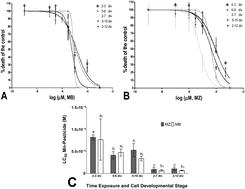当前位置:
X-MOL 学术
›
Metallomics
›
论文详情
Our official English website, www.x-mol.net, welcomes your feedback! (Note: you will need to create a separate account there.)
Manganese-induced neurotoxicity in cerebellar granule neurons due to perturbation of cell network pathways with potential implications for neurodegenerative disorders
Metallomics ( IF 3.4 ) Pub Date : 2020-07-21 , DOI: 10.1039/d0mt00085j Raúl Bonne Hernández 1 , Montserrat Carrascal , Joaquin Abian , Bernhard Michalke , Marcelo Farina , Yasmilde Rodriguez Gonzalez , Grace O Iyirhiaro , Houman Moteshareie , Daniel Burnside , Ashkan Golshani , Cristina Suñol
Metallomics ( IF 3.4 ) Pub Date : 2020-07-21 , DOI: 10.1039/d0mt00085j Raúl Bonne Hernández 1 , Montserrat Carrascal , Joaquin Abian , Bernhard Michalke , Marcelo Farina , Yasmilde Rodriguez Gonzalez , Grace O Iyirhiaro , Houman Moteshareie , Daniel Burnside , Ashkan Golshani , Cristina Suñol
Affiliation

|
Manganese (Mn) is essential for living organisms, playing an important role in nervous system function. Nevertheless, chronic and/or acute exposure to this metal, especially during early life stages, can lead to neurotoxicity and dementia by unclear mechanisms. Thus, based on previous works of our group with yeast and zebrafish, we hypothesized that the mechanisms mediating manganese-induced neurotoxicity can be associated with the alteration of protein metabolism. These mechanisms may also depend on the chemical speciation of manganese. Therefore, the current study aimed at investigating the mechanisms mediating the toxic effects of manganese in primary cultures of cerebellar granule neurons (CGNs). By exposing cultured CGNs to different chemical species of manganese ([[2-[(dithiocarboxy)amino]ethyl]carbamodithioato]](2-)-kS,kS′]manganese, named maneb (MB), and [[1,2-ethanediylbis[carbamodithioato]](2-)]manganese mixture with [[1,2-ethanediylbis[carbamodithioato]](2-)]zinc, named mancozeb (MZ), and manganese chloride (MnCl2)), and using the MTT (3-(4,5-dimethylthiazol-2-yl)-2,5-diphenyltetrazolium bromide) assay, we observed that both MB and MZ induced similar cytotoxicity (LC50 ∼ 7–9 μM), which was higher than that of MnCl2 (LC50 ∼ 27 μM). Subsequently, we applied systems biology approaches, including metallomics, proteomics, gene expression and bioinformatics, and revealed that independent of chemical speciation, for non-cytotoxic concentrations (0.3–3 μM), Mn-induced neurotoxicity in CGNs is associated with metal dyshomeostasis and impaired protein metabolism. In this way, we verified that MB induced more post-translational alterations than MnCl2, which can be a plausible explanation for cytotoxic differences between both chemical species. The metabolism of proteins is one of the most energy consuming cellular processes and its impairment appears to be a key event of some cellular stress processes reported separately in other studies such as cell cycle arrest, energy impairment, cell signaling, excitotoxicity, immune response, potential protein accumulation and apoptosis. Interestingly, we verified that Mn-induced neurotoxicity shares pathways associated with the development of Alzheimer's disease, Amyotrophic Lateral Sclerosis, Huntington's disease, and Parkinson's disease. This has been observed in baker's yeast and zebrafish suggesting that the mode of action of Mn may be evolutionarily conserved.
中文翻译:

由于细胞网络通路的扰动,锰诱导的小脑颗粒神经元神经毒性对神经退行性疾病有潜在影响
锰 (Mn) 是生物体所必需的,在神经系统功能中起着重要作用。然而,长期和/或急性暴露于这种金属,特别是在生命早期阶段,可能会通过不清楚的机制导致神经毒性和痴呆。因此,基于我们小组先前对酵母和斑马鱼的研究,我们假设介导锰诱导的神经毒性的机制可能与蛋白质代谢的改变有关。这些机制也可能取决于锰的化学形态。因此,目前的研究旨在研究介导小脑颗粒神经元 (CGN) 原代培养物中锰毒性作用的机制。通过将培养的 CGN 暴露于不同化学种类的锰 ([[2-[(二硫代羧基)氨基]乙基]氨基二硫代]](2-)-kS , kS ']锰,命名为 maneb (MB) 和 [[1,2-乙二基双 [氨基二硫代]](2-)] 锰与 [[1,2-乙二基双 [氨基二硫代]](2-)] 锌的混合物,命名为代森锰锌 (MZ) 和氯化锰 (MnCl 2 )),并使用 MTT(3-(4,5-二甲基噻唑-2-基)-2,5-二苯基溴化四唑)测定,我们观察到 MB 和MZ 诱导类似的细胞毒性 (LC 50 ∼ 7–9 μM),高于 MnCl 2 (LC 50∼ 27 μM)。随后,我们应用了系统生物学方法,包括金属组学、蛋白质组学、基因表达和生物信息学,并揭示了独立于化学形态,对于非细胞毒性浓度(0.3-3 μM),Mn 诱导的 CGN 神经毒性与金属稳态失衡和蛋白质代谢受损。通过这种方式,我们证实了 MB 比 MnCl 2诱导了更多的翻译后改变,这可能是对两种化学物质之间细胞毒性差异的合理解释。蛋白质代谢是消耗能量最多的细胞过程之一,其受损似乎是其他研究中单独报道的某些细胞应激过程的关键事件,如细胞周期停滞、能量受损、细胞信号传导、兴奋性毒性、免疫反应、潜在蛋白质积累和细胞凋亡。有趣的是,我们证实锰诱导的神经毒性与阿尔茨海默病、肌萎缩侧索硬化症、亨廷顿病和帕金森病的发展相关的通路相同。这已经在面包酵母和斑马鱼中观察到,这表明锰的作用模式可能在进化上是保守的。
更新日期:2020-07-21
中文翻译:

由于细胞网络通路的扰动,锰诱导的小脑颗粒神经元神经毒性对神经退行性疾病有潜在影响
锰 (Mn) 是生物体所必需的,在神经系统功能中起着重要作用。然而,长期和/或急性暴露于这种金属,特别是在生命早期阶段,可能会通过不清楚的机制导致神经毒性和痴呆。因此,基于我们小组先前对酵母和斑马鱼的研究,我们假设介导锰诱导的神经毒性的机制可能与蛋白质代谢的改变有关。这些机制也可能取决于锰的化学形态。因此,目前的研究旨在研究介导小脑颗粒神经元 (CGN) 原代培养物中锰毒性作用的机制。通过将培养的 CGN 暴露于不同化学种类的锰 ([[2-[(二硫代羧基)氨基]乙基]氨基二硫代]](2-)-kS , kS ']锰,命名为 maneb (MB) 和 [[1,2-乙二基双 [氨基二硫代]](2-)] 锰与 [[1,2-乙二基双 [氨基二硫代]](2-)] 锌的混合物,命名为代森锰锌 (MZ) 和氯化锰 (MnCl 2 )),并使用 MTT(3-(4,5-二甲基噻唑-2-基)-2,5-二苯基溴化四唑)测定,我们观察到 MB 和MZ 诱导类似的细胞毒性 (LC 50 ∼ 7–9 μM),高于 MnCl 2 (LC 50∼ 27 μM)。随后,我们应用了系统生物学方法,包括金属组学、蛋白质组学、基因表达和生物信息学,并揭示了独立于化学形态,对于非细胞毒性浓度(0.3-3 μM),Mn 诱导的 CGN 神经毒性与金属稳态失衡和蛋白质代谢受损。通过这种方式,我们证实了 MB 比 MnCl 2诱导了更多的翻译后改变,这可能是对两种化学物质之间细胞毒性差异的合理解释。蛋白质代谢是消耗能量最多的细胞过程之一,其受损似乎是其他研究中单独报道的某些细胞应激过程的关键事件,如细胞周期停滞、能量受损、细胞信号传导、兴奋性毒性、免疫反应、潜在蛋白质积累和细胞凋亡。有趣的是,我们证实锰诱导的神经毒性与阿尔茨海默病、肌萎缩侧索硬化症、亨廷顿病和帕金森病的发展相关的通路相同。这已经在面包酵母和斑马鱼中观察到,这表明锰的作用模式可能在进化上是保守的。



























 京公网安备 11010802027423号
京公网安备 11010802027423号